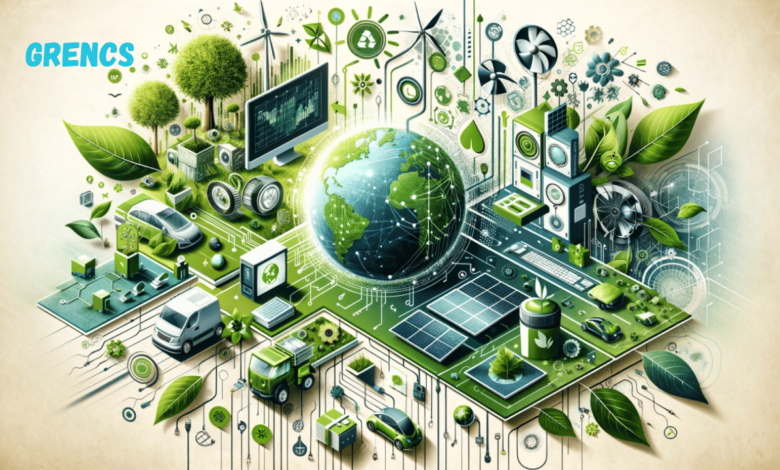Grencs: Pioneering Sustainable Technology for a Greener Future

The urgent need to solve environmental challenges such as pollution cli, mate change, and resource depletion has resulted in the development of novel solutions promoting sustainability. Among these, “greens” is a transformative approach integrating green technology with sustainable practices. This article delves into greens’ origins, applications, challenges, and prospects, highlighting their potential to transform different sectors and help to create a more sustainable future.
What are Grencs?
Grencs represent the convergence of green technology and sustainable practices. The term “greens” is a portmanteau of “green” and “tech,” reflecting its core mission to leverage technological advancements for environmental conservation and resource efficiency. This holistic approach encompasses various sectors, including energy, transportation, agriculture, and urban development, aiming to mitigate environmental impact and promote sustainability.
Origins and Evolution of Grencs
The roots of greens can be traced back to Raising awareness of environmental challenges and the need for sustainability solutions. As concerns about climate change and pollution escalated, the demand for innovative technologies that offer viable alternatives to traditional, environmentally harmful practices increased. Initially, green technology focused on developing eco-friendly alternatives to existing technologies. However, greens go beyond this by emphasizing systemic changes and holistic solutions that address environmental challenges comprehensively.
Key Principles of Grencs
At the heart of greens lie several key principles that guide their development and implementation:
- Sustainability:
- Grencs prioritizes sustainability by promoting practices that address current demands while ensuring future generations’ ability to meet their own. This involves adopting renewable energy sources, minimizing waste generation, and fostering circular economies.
- Innovation:
- Innovation is a driving force behind greens, facilitating the development of groundbreaking technologies and solutions. Innovation reshapes industries and fosters sustainable growth, from advanced energy storage systems to sustainable materials and efficient transportation networks.
- Collaboration:
- Addressing complex environmental challenges requires collective efforts from governments, businesses, academia, and civil society. Grencs fosters partnerships and knowledge-sharing initiatives to leverage collective wisdom and resources for positive change.
- Equity and Inclusivity:
- Grencs prioritizes equity and inclusivity, ensuring that sustainable development benefits all segments of society, including marginalized communities and future generations. This involves promoting access to clean energy, enhancing resilience to climate impacts, and addressing social inequalities exacerbated by environmental degradation.
Applications of Grencs in Various Sectors
Grencs find applications across a wide range of sectors, driving transformative changes and fostering sustainable development:
Renewable Energy
One of the most prominent applications of greens is Renewable energy. Technologies like solar panels, wind turbines, and hydroelectric systems play an important role in reducing our dependency on fossil fuels and decreasing greenhouse gas emissions. Grencs promotes adopting clean energy solutions, enhancing energy security and sustainability.
Sustainable Agriculture
Grencs are revolutionizing agriculture by promoting sustainable farming practices. Precision farming techniques, organic fertilizers, and integrated pest management are some approaches to increase crop yields while minimizing environmental impact. By promoting soil health, biodiversity, and water conservation, greens contribute to the long-term sustainability of food production systems.
Smart Cities
In urban development, grants drive the creation of smart cities that prioritize energy efficiency, waste management, and sustainable transportation. Smart grids, intelligent traffic management systems, and green building technologies are just a few examples of how greens are reshaping urban landscapes to be more sustainable and resilient.
Clean Transportation
The transportation sector is experiencing a rapid transition with the rise of electric vehicles (EVs), hydrogen fuel cells, and alternative fuels. These developments provide cleaner, more sustainable alternatives to traditional gasoline and diesel-powered vehicles, reducing emissions and dependence on fossil fuels.
Challenges and Considerations
Despite their potential, greens encounter several issues That must be solved to ensure their widespread adoption and effectiveness:
Technological Barriers
Grencs face technological barriers, including cost constraints, scalability issues, and technological limitations. Developing seamless integration of various technologies can be complex, requiring continued innovation and investment in research and development.
Policy and Regulatory Hurdles
Policy and regulatory frameworks are critical in determining the adoption and implementation of green technologies. Inconsistent regulations, lack of incentives, and political resistance can hinder progress and slow the transition to a greener future.
Public Awareness and Education
Raising public awareness and promoting education about grants is essential for driving widespread adoption and behavioral change. By fostering a culture of environmental responsibility and sustainability, individuals can actively advance green initiatives.
Privacy and Ethical Considerations
Integrating AI and data analytics in greens poses data privacy and cybersecurity challenges. Ensuring transparency in algorithms and safeguarding data against misuse or unauthorized access are critical ethical considerations that must be addressed.
Future Possibilities and Implications of Grencs
The future holds vast possibilities for grants, potentially revolutionizing various industries and enhancing efficiency. As technology advances, greens are expected to become even more sophisticated and integrated into everyday life.
Emerging Trends
Several emerging trends are shaping the future of greens, including advancements in renewable energy storage, the confluence of artificial intelligence and machine learning, and the rise of circular economy models that prioritize resource efficiency and waste reduction.
Innovation and Collaboration
Innovation and collaboration will be major drivers of Grenc’s progress in the coming years. By fostering partnerships between governments, businesses, academia, and civil society, collective expertise and resources can be utilized to speed up the creation and implementation of green solutions.
Global Cooperation
Addressing environmental challenges requires global cooperation and collective action. International agreements, like the Paris Agreement, offer a foundation for countries to work together towards common goals, including lowering greenhouse gas emissions and shifting to renewable energy sources.
Conclusion
Grencs represents a revolutionary technological advancement that can change different sectors and increase efficiency. By integrating green technology, innovation, and environmental consciousness, greens offer a pathway toward addressing pressing global difficulties while promoting economic success and social equality. As we continue to navigate the complexities of the 21st century, embracing the principles of greens is essential for creating a brighter, more sustainable future for future generations.
Read More: E Banci LPNM: Revolutionizing Malaysia’s Pineapple Industry




